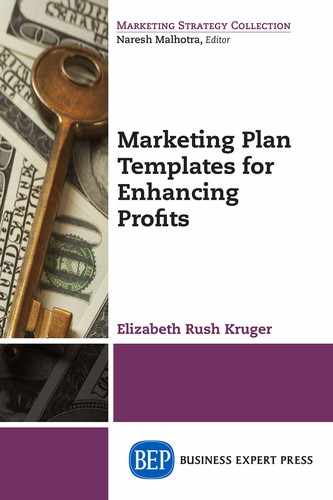Prospecting: Target Key Prospects
Overview
The vice president of marketing for the National Linen Service (NLS) in Atlanta, Georgia, concluded from my research, “No one but dinosaurs will want our service. Without new prospects, we’re going out of business!”
Alsco bought NLS trusting that its key prospects would be like its key customers. Aesop advises, “Example is better than precept.”
Many direct marketing companies use the traits of key customers to identify key prospects. For example, InfoUSA advertises, “We’ll analyze your customers to find hot prospects just like them!” Let us learn how to target key prospects with a direct marketing campaign.
Vignettes
Dinosaurs Devour the National Linen Service
My first marketing research client was the National Linen Service (NLS) in Atlanta, Georgia. My client supplied and washed rolls of linen towels for restaurants, health care facilities, and industrial settings. In 1984, the vice president of marketing for NLS asked me to compare current and past customers of their linen service.
Proudly, I brought him the research results and displayed them on his table. The vice president cued into one important fact—past customers had newer buildings than did current customers. In anger, he shoved the results off the table and said, “Our current customers are dinosaurs. No one but dinosaurs will want our service. Without new prospects, we’re going out of business!”
The vice president of marketing for NLS believed that laundering rolls of linen towels was passé, but Alsco, a worldwide leader in the industry, recognized the value of its services.

Alsco plant1
Alsco provides a full line of professionally laundered linens delivered weekly for use in Food & Beverage, Healthcare, and Industrial settings […] We deliver only the products you need, when you need them, freeing you to focus on your core business.2
How Does a Crab Learn?
An Aesop Fable
An old crab criticizes her son. “Why do you walk sideways like that, my son, and rub your sides against the wet rock? You ought to walk straight.”
Sweetly, the young crab replied, “Since you want to teach me, show me how to walk straight, my dear mother, and I’ll follow your example.”
The old crab tries, but she tries in vain. “I was foolish to find fault with you.”
Aesop advises, “Example is better than precept.”
What Are Ways to Identify Key Prospects
Who Are Key Prospects?
Was Aesop right—do we learn best by example? Can key customers predict who will be your key prospects? In fact, many direct marketing companies use the traits of key customers to identify key prospects. A business can use one trait or several traits of its key customers to target key prospects.
For example, the Advanced Customer Cloner by InfoUSA targets prospects in the United States and Canada. “We’ll analyze your customers to find hot prospects just like them!”
Who Are Key Business Prospects?
InfoUSA compiles information about 17 million businesses on dozens of traits. Its sources include Yellow Page directories, government sources, annual reports, press releases, and websites. For example, a business can find distributors who spend at least a million dollars on travel. Maybe a business wants to target growing retail businesses in the Chicago metropolitan area. A government contractor can even identify certified minority contractors with a certain specialty, size, and longevity.
Who Are Key Consumer Prospects?
InfoUSA uses a hundred sources to update descriptions of about 230 million consumers. For example, a business can identify young women who recently bought a home in its area. Is your target market mail-order buyers who subscribe to a car magazine? Other examples are locating diabetic pharmacists or major donors who are civic leaders in a small InfoUSA can also locate unemployed graduates in mass communication who spend hours on the Internet and buy many electronics. community.3
What Are the Steps to Higher Profits?
Step One
The first step is to describe and delight key customers. According to the 80/20 rule, the most profitable 20 percent of the customers will generate 80 percent of the profits. Delight them by designing products and services especially for them and by discontinuing other items. Consistently deliver them value for the price and promote your empathy for key customers. The business must quit producing, distributing, and promoting items for other customers and stop wasting resources on the 80 percent of the customers who only generate 20 percent of the profits.
Step Two
The second step is to promote to prospects who are similar to your key customers. Like them, these prospects will be delighted with your business. These key prospects will be easy to convert into highly profitable new customers. When they replace lost customers, the business will magnify its profits (Figures 9.1 and 9.2 and Table 9.1).

Figure 9.1 Focus on key customers

Figure 9.2 Duplicate key customers
Table 9.1 Steps in prospecting
|
Customers |
Inputs |
Profits |
|
Original customers |
100% |
100% |
|
Describe and delight key customers |
20% |
80% |
|
Duplicate key customers |
100% |
400% |
An Example of the Steps
My beautician is a young woman with deep purple hair and an eyebrow stud. Jessica worked for J. C. Penney’s Beauty Salon in Volusia Mall, Daytona Beach, Florida. (The amounts in this example are estimates.)
Each year Jessica beautified around 1,000 regulars and walk-in shoppers, and they averaged four visits per year. After subtracting her overhead, Jessica earned roughly $10 per head so her annual income was around $40,000 per year (Table 9.2).
Table 9.2 Steps in targeting key prospects
|
Clients |
Visits each |
Total visits |
Profit |
|
|
Penney’s salon |
1,000 |
4 |
4,000 |
$40,000 |
|
Beautiful salon, year 1 |
800 |
1 |
800 |
$8,000 |
|
Beautiful salon, year 2 |
1000 |
4 |
4,000 |
$40,000 |
Every August, Penney’s back-to-school promotion offered children free haircuts and paid the beauticians a pittance for their work. Jessica whispered to me, “I hate to cut their tangled manes. The kids challenge my patience, pre-empt my regulars, and cut my profits.” She vowed to never again participate in Penney’s back-to-school promotion.
Jessica moved her business to Beautiful Salon & Day Spa in Ormond Beach, Florida, an owner-managed salon in an upscale mall. About 80 percent of her clients (80% × 1000 = 800) followed Jessica to the Beautiful Salon, but they produced only about 20 percent of her profits at Penney’s Salon (20% × $40,000 = $8,000). The other 20 percent (20% × 1000 = 200) were frequent patrons or employees of J. C. Penney’s. They averaged 16 visits per year and produced about 80 percent of her profits at Penney’s (80% × $40,000 = $32,000).
Disappointed, Jessica identified the most profitable 20 percent of her remaining clients (20% × 800 = 160). They averaged four visits per year and produced roughly 80 percent of her profits (80% × $8,000 = $6,400). Her other 640 clients only produced around 20 percent of her profits (20% × $8,000 = $1,600) so she delegated them to another beautician who could better satisfy them.
Jessica offered her key clients a discount for referring their friends to her. They and their friends attracted 840 highly profitable new clients. Just like her key clients, they averaged four visits a year and produced generous profits (840 × 4 × $10 = $33,600). Soon Jessica was again earning around $40,000 per year from 1000 clients.
Key #9: Target Key Prospects

John Romero4
In marketing I’ve seen only one strategy that can’t miss—and that is to market to your best customers first, your best prospects second, and the rest of the world last.
John Romero, video game designer, cofounder of Id Software.
Embry-Riddle Aeronautical University Soars
Embry-Riddle Aeronautical University (ERAU) educates students at residential campuses in Daytona Beach, Florida and Prescott, Arizona, and through more than 150 locations in the United States, Europe, Asia, Canada, and the Middle East. ERAU expects to double in size by 2020. “Embry-Riddle Aeronautical University is the world’s largest, fully accredited university specializing in aviation and aerospace.”
This school is best suited for aviation enthusiasts—people that want to pursue a career in aviation business management, engineering, air traffic control, and piloting.5

Jets for the ERAU’s flight team6
Its key prospects are college-prep high school students who are aviation enthusiasts. Currently, ERAU offers a $1,000 per year scholarship to students who are referred by alumni. Another way is to use InfoUSA’s Advanced Customer Cloner to match the top 20% of its students with prospects in the United States and Canada. These are many other ways ERAU could identify key prospects.
- Solicit referrals from InfoUSA’s list of Airplane Owners and Pilots.
- Contact teenage members of Academy of Model Aeronautics clubs and participants in its model competitions.7
- Contact teenage members of Experimental Aircraft Association (EAA) chapters around the world.8
- Collect contact information from high school students who attend air shows. For example, the EAA sponsors AirVenture Oshkosh, one of the largest air shows in the world. In 2015, ERAU is sponsoring 20 events and workshops plus performances by its Eagles Flight Team.9
You can learn from these examples how to target key prospects of the business with a direct marketing campaign.
Summary
Aesop advises, “Example is better than precept.” Many direct marketing companies use the traits of key customers to identify key prospects. For example, InfoUSA advertises, “We’ll analyze your customers to find hot prospects just like them!”
The first step is to describe and delight key customers. The second step is to target prospects who are similar to your key customers.
These key prospects will be easy to convert into highly profitable new customers. When they replace lost customers, the business will multiply its profits. Examples of a beautician and ERAU demonstrate this process. The ninth key to enhancing profits is to target key prospects.
 Target Key Prospects Like Its Key Customers
Target Key Prospects Like Its Key Customers
Decide how the business will target key prospects:
1a. Target key business clients by describing a few of their most important traits from this list of possibilities:
- Type of business: SIC or NAICS code, Yellow Page heading, and sales volume
- Category of business: new, home-based, small, growing, big, or bankrupt
- Management: gender, ethnicity, title, occupation, profession, and ownership
- Spending: credit rating, computers, and other business expenses by category
- Other information: location, longevity, number of employees, and brand
1b. Target key consumers by describing a few of their most important traits from this list of possibilities:
- Household: socioeconomic status, housing, investments, and donations
- Spending: vehicles, electronics, other expenses, and credit card use
- Residents: gender, age, ethnicity, religion, income, insurance, or occupation
- Major event: new home owners, bankruptcy, and college students by field
- Usage: subscriptions, medications, mail ordering, and online activities
- Lifestyle: opinions, interests, hobbies, and social group
2. What traits will the business actually use to target key prospects with a direct marketing campaign?
